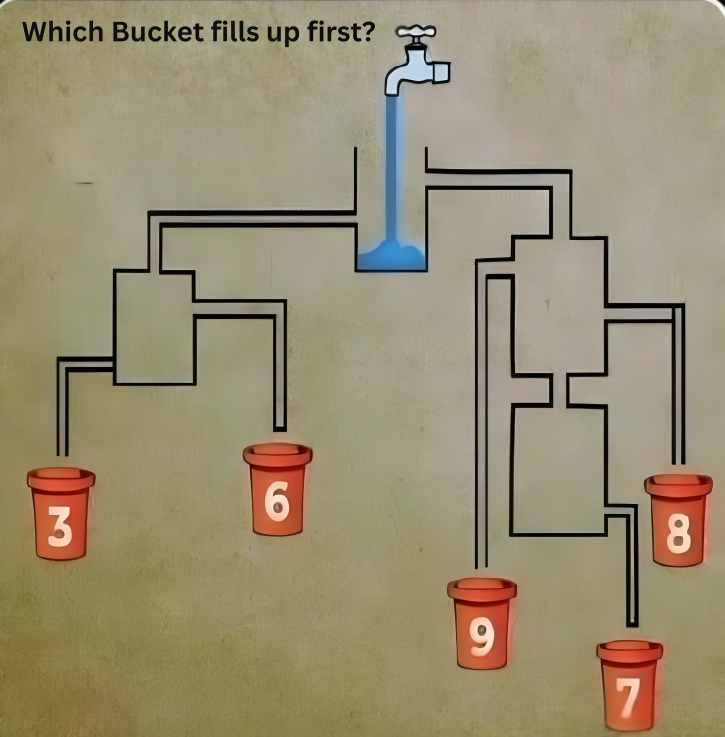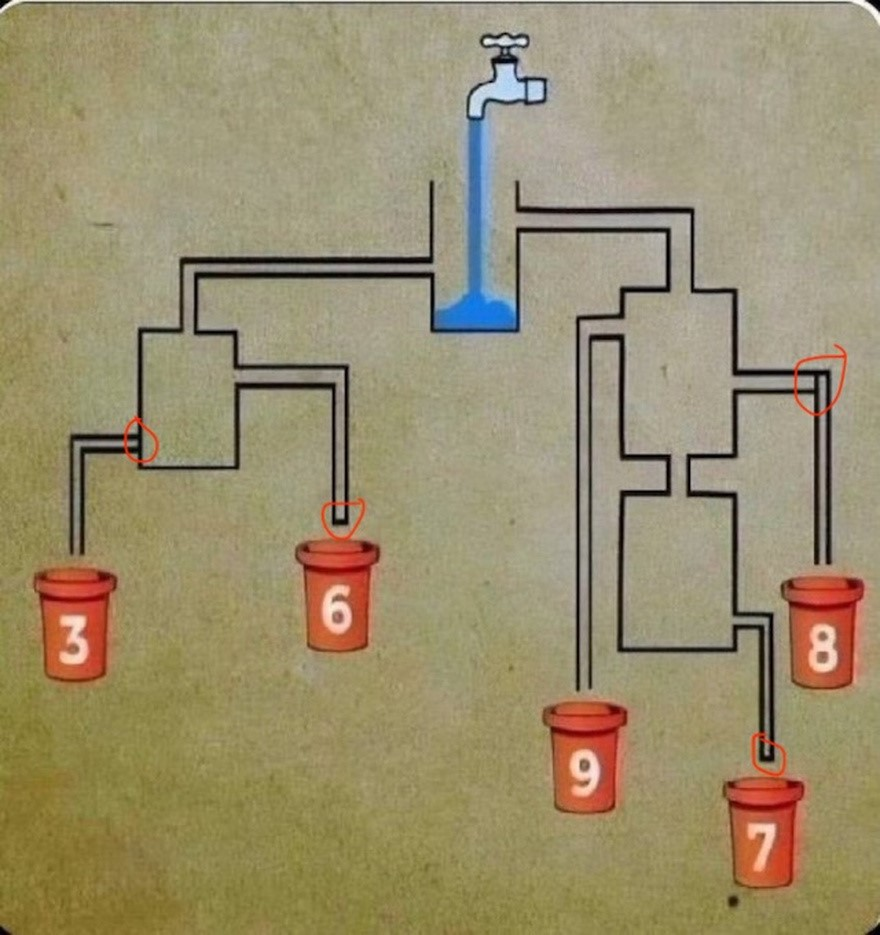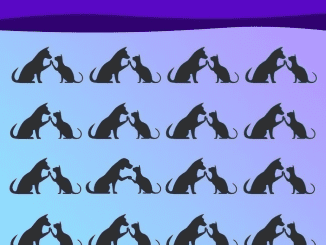Here’s a puzzle that looks simple—but it’s designed to trick your eyes and challenge your brain. You’ve got a water tap, a complex network of pipes, and six buckets numbered 3, 6, 7, 8, and 9. The question is: Which bucket fills up first when the tap is turned on?
At first glance, you might think the answer is obvious. But don’t be fooled. This kind of visual brain teaser is loaded with distractions, and most people get it wrong on their first try. Want to prove your sharp thinking skills? Keep reading, take a closer look at the puzzle, and see if you can solve it before we reveal the answer.
This Puzzle Is a Trap (But a Clever One)

This isn’t just about water flowing from a faucet—it’s about how you think through a problem. The pipes are deliberately drawn to mislead you. Some are blocked. Others appear to be connected but aren’t. And that’s where most people go wrong—they assume the shortest route is the correct one, or they miss small details like closed valves or dead-end pipes.
Common Mistakes People Make With This Puzzle
- Following the longest path
Some people think the water has to flow through all the buckets before one fills. But this puzzle isn’t about distance—it’s about open paths. Water only flows through open, unblocked pipes. - Not noticing closed paths
Many of the pipes in the diagram are blocked—if you look closely, you’ll see horizontal bars that indicate the water cannot pass. Ignoring those blocks leads people to pick buckets that will never get water. - Assuming all pipes are functional
Your brain wants to assume that every pipe leads somewhere and every bucket is a candidate. But the trick is to notice which pipes are closed off and which aren’t.
So, how do we solve it? Let’s walk through it step by step.
Step-by-Step Puzzle Breakdown: How to Solve It
Let’s trace the path of the water from the tap at the top:
- Water begins at the top and flows downward. It hits a split that leads left toward buckets 3 and 6, and right toward buckets 8, 9, and 7.
Video : Which bucket will get Filled first 🙄?
Left Side Analysis:
- Bucket 3’s pipe is blocked at the junction. Water cannot pass through it.
- Bucket 6 looks promising at first, but if you look carefully, its pipe is also blocked. There’s a valve right before the water would drop into the bucket, stopping the flow completely.
That means none of the left-side buckets (3 and 6) will receive any water.
Right Side Analysis:
Now focus on the right path:
- Water goes down toward a T-junction.
- The first turn to the right would send water toward bucket 8. But that path is blocked.
- The next fork goes to bucket 7. Again, a closer look shows that there is a closed pipe just before the water reaches bucket 7.
- That leaves only one open path—the one leading straight down to bucket 9.
There are no blockages in the pipe leading to bucket 9. No dead ends. No valves. Just a clear, straight flow from the tap. So, as soon as the water starts flowing, bucket 9 begins to fill first—and it’s the only bucket that gets water at all.
Final Answer: Bucket 9 is the first to fill up.
Why Bucket 9? The Logic Behind It
This puzzle teaches a simple but powerful lesson: observation is everything. You can’t rush through a visual problem without carefully analyzing each step and detail. The small blocks in the pipes? Those tiny lines are the entire key to the puzzle.

It also highlights how our minds tend to overcomplicate things. We assume it’s about which bucket is closest or which one appears under the tap. In reality, the puzzle is about one thing—accessibility. Water follows the path of least resistance. So should your logic.
What This Puzzle Teaches You About Logical Thinking
These types of puzzles are more than fun—they’re training for your brain. Here’s what you strengthen every time you try to solve one:
- Attention to detail: Missing one tiny valve can lead to the wrong answer.
- Critical thinking: You learn to question what looks obvious and dig deeper.
- Visual analysis: Spotting blockages and dead ends trains your eyes and mind to work together.
- Patience: Rushing leads to failure. Careful observation brings clarity.
In a world that’s always moving fast, exercises like this slow you down and sharpen your thinking.
Your Turn: Did You Get It Right?
How many of you guessed bucket 9? Be honest—did you see it on your first try, or did you fall for one of the traps? Comment below with your answer before and after reading the explanation. Share your thought process—did you spot the blocked pipes? Did you follow the water all the way through?
Video : Which Bucket Wil Fill First
And if you got it right without any help, congratulations! You’ve got a strong eye for logic and detail.
Challenge Your Friends and Keep the Brain Games Going
Now that you’ve cracked this puzzle, share it with friends and family. See how many of them fall for the common traps. It’s always fun to watch someone confidently guess only to realize they missed a key detail!
And if you enjoyed this, don’t stop here. Try more brain teasers, riddles, and logic puzzles. Every time you take on a challenge like this, you’re sharpening your brain, boosting your focus, and building powerful cognitive skills that help in everyday life.
Because at the end of the day, the smartest people aren’t always the fastest—they’re the ones who look twice, think deeper, and question everything.


